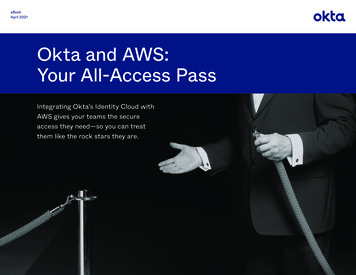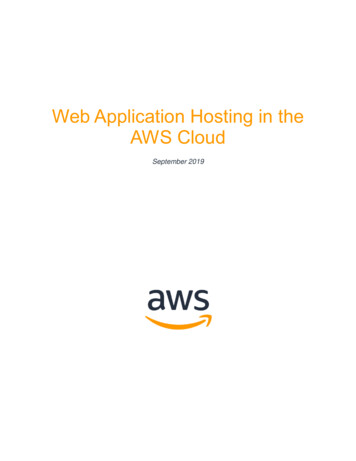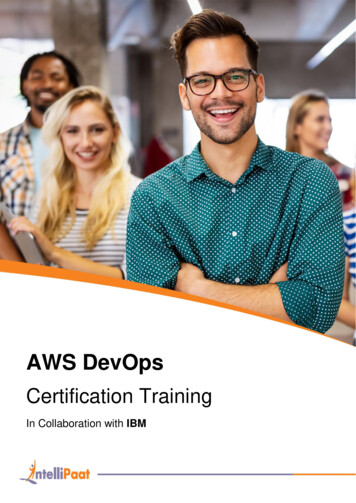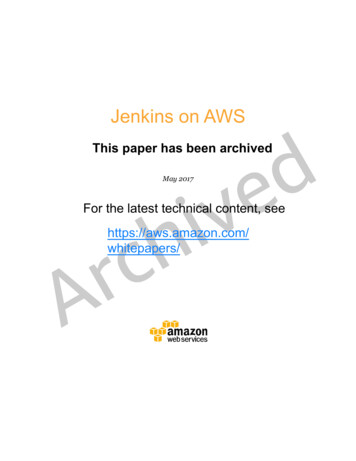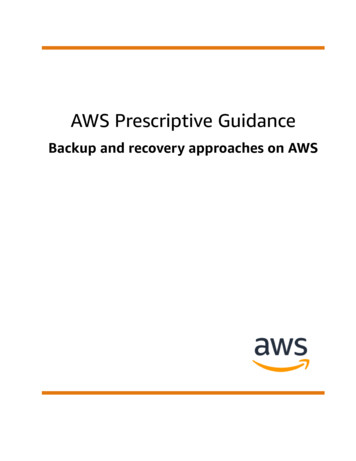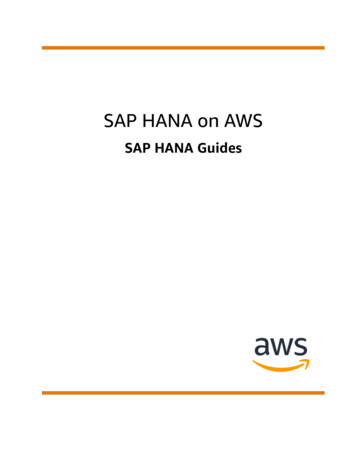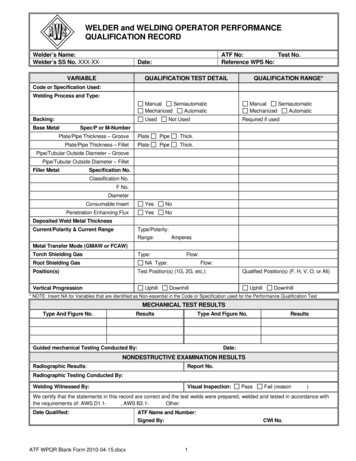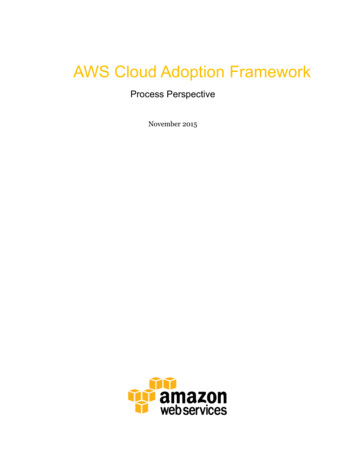
Transcription
AWS Cloud Adoption FrameworkProcess PerspectiveNovember 2015
Amazon Web Services – AWS CAF Process PerspectiveNovember 2015 2015, Amazon Web Services, Inc. or its affiliates. All rights reserved.NoticesThis document is provided for informational purposes only. It represents AWS’scurrent product offerings and practices as of the date of issue of this document,which are subject to change without notice. Customers are responsible formaking their own independent assessment of the information in this documentand any use of AWS’s products or services, each of which is provided “as is”without warranty of any kind, whether express or implied. This document doesnot create any warranties, representations, contractual commitments, conditionsor assurances from AWS, its affiliates, suppliers or licensors. The responsibilitiesand liabilities of AWS to its customers are controlled by AWS agreements, andthis document is not part of, nor does it modify, any agreement between AWSand its customers.Page 2 of 29
Amazon Web Services – AWS CAF Process PerspectiveNovember 2015ContentsAbstract5Introduction5Service Delivery Management7Transform Your Business with DevOps7You Build It—You Run It8Why Culture Matters9Considerations11Portfolio Management12Increase Frequency of Planning Cycles12Drive Alignment Through Portfolio Governance12Think Sourcing Before Hosting13Gain Visibility and Collaboration14Considerations15Program and Project Management16Outcome-Driven Planning16Complex Enterprise System Challenges16Maintain Small Teams to Scale17Considerations17Continuous Integration and Continuous Delivery (CI/CD)18Achieve Continuous Integration18Implement Deployment Pipelines19Deployment Is Not Release19Considerations20Process Automation21Considerations22Quality ManagementPage 3 of 2924
Amazon Web Services – AWS CAF Process PerspectiveNovember 2015Lean Principles24Agile25Considerations26Conclusion26CAF Taxonomy and Terms27Notes28Page 4 of 29
Amazon Web Services – AWS CAF Process PerspectiveNovember 2015AbstractThe Amazon Web Services (AWS) Cloud Adoption Framework (CAF)1 providesbest practices and prescriptive guidance to accelerate an organization's move tocloud computing. The AWS CAF guidance is broken into a number of areas offocus that are relevant to implementing cloud-based IT systems. These focusareas are called perspectives. Each perspective is covered in a separatewhitepaper. This paper covers the Process Perspective. The considerations in thisperspective can help you ensure that all your enterprise processes are in place toplan, implement, and operate cloud-based IT capabilities.IntroductionThe Process Perspective covers activitiesacross the IT lifecycle for cloud adoption.The focus is on managing IT initiatives as aportfolio to optimize investments, deliverservices that meet quality objectives, andcarry out work through well-definedprograms and projects. For cloud-basedsoftware development, you can use agileand iterative lifecycles to deliverfunctionality incrementally and to catch andfix defects early. You can use continuousintegration/continuous deliveryFigure 1 Components of the Process(CI/CD) practices to automatePerspectivebuilding, testing, and deployingsoftware. You can also use CI/CD toautomate operational processes to improve the resilience of the solutions andreduce manual effort. Figure 2, gives you a high-level look at the processperspective components, activities, and artifacts that are discussed in this paper.Page 5 of 29
Amazon Web Services – AWS CAF Process PerspectiveAWS CAF ProcessActivitiesNovember 2015ArtifactsComponentPortfolio Management Service DeliveryManagement Program & ProjectManagement Continuous Integration &Continuous Delivery Process Automation Quality Management Define economic framework fordecision makingShorten planning cyclesApply goal-orientedrequirements engineeringtechniques to get to targetconditions Adjust existing service deliveryprocessesInstitute Lean-Agile engineeringpracticesTarget a DevOps culture Establish a portfolio to manageall business and IT capabilitiesIntegrate cloud-based ITservices into your currentSourcing Model Enterprise IT DomainDiagramEnterprise IT Capabilities toEnterprise Domain MatrixEconomic framework thatincludes the cost of delayImpact MapLean-Agile engineeringtechniquesDevOps practices Enterprise PortfoliospreadsheetSourcing ModelAWS Application MigrationMethodAWS Migration FactoryDocument current SDLCpracticesDevelop approach for teams toadopt CI/CD practices viacontinuous improvementpracticesImplement Delivery Pipelines CI/CD Tools MatrixDocument current processesusing Value Stream Mapping orother techniquesIdentify and prioritize processoptimization opportunitiesIdentify and prioritize processautomation opportunities Value Stream MapActivity Based AccountingInstitute continuousimprovement practicesIncorporate continuousimprovement into all your ITpractices Value Stream MappingTheory of ConstraintsRoot-Cause AnalysisImprovement KataCoaching KataPlan, Do, Check, Act (PDCA) Figure 2: Process Perspective Activities and ArtifactsPage 6 of 29
Amazon Web Services – AWS CAF Process PerspectiveNovember 2015Service Delivery ManagementTheService Delivery Management component of the AWS CAF Processperspective promotes leveraging people, processes, and technologies in ways thathelp you optimize how you deliver business outcomes. Consider using thefollowing approach to start taking advantage of cloud-based IT services tooptimize your service delivery processes:1. Document your current service delivery processes.2. Review the target outcomes you defined during your cloud strategydevelopment activities.3. Identify the minimum process modifications required to support theoutcomes defined in your cloud strategy.4. After you understand your desired target state, start working throughinternal change management processes to begin the change process.Figure 3 provides an example of an IT lifecycle and the key areas for review todetermine your target state.Figure 3: IT LifecycleThis approach will ensure you have done the minimum required to adoptsuccessfully cloud-based IT capabilities into your service delivery processes.Transform Your Business with DevOpsTo achieve the greatest value from adopting cloud-based IT services, you shouldconsider adopting Lean agile engineering practices and a DevOps culture. AsPage 7 of 29
Amazon Web Services – AWS CAF Process PerspectiveNovember 2015Damon Edwards has stated, “The whole point of DevOps is to enable yourbusiness to react to market forces as quickly, efficiently, and reliably aspossible.”2 It does this by focusing on optimizing your service value streams thatencompass every step from idea inception through customer consumption. Thistype of transformation has enabled Amazon and many other companies toachieve innovation at ever-increasing scales.You Build It—You Run ItLeveraging DevOps in a cloud-based IT delivery model provides many benefits.Werner Vogels, the CTO at AWS has said, “You build it, you run it.” In a 2006interview, Vogels describes the value of moving away from an operating modelwhere separate teams develop and operate services to a model where a singleteam both develops and operates a service. “The small-team concept means thatyou have a continuous feedback loop where you try to understand the impact forthe customer.”3Consider making the following improvements to realize the value DevOps canbring to your IT operating model:4 Design for production—“Run what you build” forces development teamsto think about how their software is going to run in production as they designit. This can help your teams avoid the last minute scrambling that often occurswhen teams try to force-fit what they’ve built to a production environment tomeet a deadline. This is an all too common occurrence that materially hurtsquality. You change something at deployment time to address somethingthat’s different between production and development. Next, you run what youthink are the relevant tests, and later discover that this change caused a bugsomewhere else in the system. Encourage greater employee autonomy—The “you build it, you run it”mentality encourages ownership and accountability and can lead to moreindependent, responsible employees and greater potential career growth inthe organization. Implement greater transparency—Your teams will naturally wantgreater transparency in the environment, so it would be helpful to implementproactive monitoring so they can identify issues and concerning patternsbefore they become widespread problems. Transparency should make it mucheasier to find root causes for issues that still make it through, ultimatelyleading to increased uptime and improved service quality.Page 8 of 29
Amazon Web Services – AWS CAF Process PerspectiveNovember 2015 Build in more automation—Developers hate repeating manual tasks. So,instead of having developers repeat tasks in production to address an issue,automate things along the way so that developers can discover root causes ofissues earlier. Continually improve operational quality—Continual improvementpractices, feedback loops, and test-driven development, along withautomation and transparency can lead to higher quality services for yourinternal and external customers. Learn more about satisfying customers—“Run what you build” forcesthe entire IT team to understand more about the customer. Knowledge will nolonger be limited to a product or sales team. Developers can include customerfeedback metrics in their software to quantify the value of each feature to theircustomers.Why Culture MattersThe Puppet Labs 2015 State of DevOps Report acknowledges, “Culture is themost important ingredient of DevOps.”5 The report measured a company’sculture and IT performance and demonstrated a strong link between the two.Good DevOps practices generate high trust in the organizational culture. Thesepractices are a factor in what Ron Westrum calls a “generative performanceoriented” culture. Figure 4 shows Westrum’s comparison of three differentorganizational cultures and their ow cooperationModest cooperationHigh cooperationMessengers shotMessengers neglectedMessengers trainedResponsibility shirkedNarrow responsibilitiesRisks are sharedBridging discouragedBridging toleratedBridging encouragedFailure leads to scapegoatingFailure leads to justiceFailure leads to inquiryNovelty crushedNovelty leads to problemsNovelty implementedFigure 4: Typology of Organizational Culture (Westrum, 2004)Figure 5 provides additional practices from the Puppet Labs report that will helpyou achieve a strong DevOps culture.Page 9 of 29
Amazon Web Services – AWS CAF Process PerspectiveCharacteristicsNovember 2015DevOps Practicesof a GenerativeCultureHigh CooperationMessengerstrainedRisks are sharedBridgingencouragedFailure leads toinquiryNoveltyimplementedCross-functional teams - Many organizations create cross-functionalteams that include representatives from each functional area of thesoftware delivery process (business analysts, developers, qualityengineers, ops, security, etc.). This allows everyone to share theresponsibility for building, deploying, and maintaining a product.Blameless post-mortems - By removing blame, you remove fear; byremoving fear, you enable teams to more effectively surface problemsand solve them. Mistakes happen. Holding blameless postmortems is avaluable way to learn from mistakes.Shared responsibilities - Quality, availability, reliability, andsecurity are everyone’s job. One way to improve the quality of yourservices is to ensure that devs share responsibility for maintaining theircode in production. The improvement in collaboration that comes fromsharing responsibility inherently reduces risk: With more eyes on thesoftware delivery process, it is a given that some errors in process orplanning will be avoided. Automation also reduces risk, and choosingthe right tool can enable collaboration.Breaking down silos - In addition to creating cross-functional teams,consider co-locating ops with the dev team and including ops inplanning throughout the software and delivery lifecycle.Blameless post-mortems - Response to failure shapes the culture ofan organization. The more you focus on the conditions in which failureshappen, as opposed to blaming individuals for failures, the closer you’llget to creating a generative culture.Experimentation time - Giving employees the freedom to explorenew ideas can lead to great outcomes. Some companies give engineerstime each week for experimentation. Others host internal hack days ormini-conferences to share ideas and collaborate. This is how many newfeatures and products have originated, and it shows how much valueemployees can generate for an organization when they are released fromhabitual pathways and repetitive tasks.Figure 5: How to create a generative culturePage 10 of 29
Amazon Web Services – AWS CAF Process PerspectiveNovember 2015Considerations Do consider adopting lean agile engineering practices and a DevOps cultureto transform your business. Do analyze your existing service delivery processes to determine which mustchange to support adoption of cloud-based IT services. Do define key metrics that the CIO will report on to the board. Do not implement and maintain separate processes and tools for cloudbased versus on-premises based IT services. Do not set service-level agreements (SLAs) unless you have activities in placeto test for compliance. Game day testing is one technique that allows you totest SLA compliance by using automated scripts to introduce failure scenariosinto your systems.Page 11 of 29
Amazon Web Services – AWS CAF Process PerspectiveNovember 2015Portfolio ManagementThe Portfolio Management component of the AWS CAF Process Perspectiveprovides executives with a method for managing new investments and identifyinghow well existing investments are delivering on desired outcomes. If you aredoing this today, then you just need to adjust your portfolio practices to includecloud-based IT services. If you are not already doing this, then you can get startedby creating an inventory of existing assets and prioritizing new products andservices in a management platform like a service catalog.Increase Frequency of Planning CyclesTraditional portfolio management typically runs on a yearly rhythm withquarterly review and reprioritization. Consider moving to lean portfoliomanagement practices that incorporate a continuous planning and managementstrategy to reduce the time to value in the delivery of solutions. Lean portfoliomanagement uses a mindset similar to high-velocity stock brokering by havingmany projects that are very frequently aligned, re-prioritized, and re-budgetedbased on their individual performance, value add, criticality, and dependency.For this approach to be effective, the practice of protecting “untouchable”programs and projects must be abandoned. By adopting this approach, you willgain the agility to change as business needs change.A Service Catalog is a foundational enabler of the IT planning and delivery cycles.It contains details about the IT systems that support business capabilities andhow those systems are sources and hosted. This information provides criticalinput for identifying and sequencing portfolio investments. Combining a robustService Catalog with governance that ensures funding and flexibility todevelopment teams can help to mature your portfolio management practices.Using model-driven and data-driven approaches to testing specific reprioritization scenarios will give you greater ability to shift portfolio prioritizationat the same speed that the business changes. For example, using modelingtechniques to test how pivoting on the cost of delay as the main prioritization keyand impact to portfolio planning might yield valuable insight.Drive Alignment Through Portfolio GovernanceAs part of an AWS cloud adoption strategy, you have an opportunity to tightenthe partnership between business and IT planning and management efforts. ByPage 12 of 29
Amazon Web Services – AWS CAF Process PerspectiveNovember 2015creating a partnership between business and technology teams, you givedevelopment teams the opportunity to collaborate directly with businesssponsors. This collaboration will lead to higher quality feature delivery andimproved customer satisfaction.Portfolio management should become your key governance body that controls theboundaries for why, what, and how demand traverses your IT lifecycle. Theportfolio management, program management, and business operations teamsshould collaborate to maintain close alignment with the business. Figure 6 is anexample of a governance model used to describe how various groups willcollaborate to accelerate delivery of capability into production.Figure 6: Governance ModelIdeally, shifting the portfolio management function to a center of excellence(CoE) function can provide teams with more autonomy and improve theirresponsiveness to changes in business requirements.Think Sourcing Before HostingMany customers view AWS services as a set of technology tools that can enhancetheir existing toolkit. They learn about AWS compute, storage, and privatenetworking services and then go about mapping their current application’scomponents to these foundational services. This approach is valid, but itreinforces a builder-centric approach to delivering IT capabilities. We have foundthat customers who first consider how they source their business and ITcapabilities achieve far greater business value using AWS.Page 13 of 29
Amazon Web Services – AWS CAF Process PerspectiveNovember 2015The Capability Sourcing Model in Figure 7 guides you through a set of decisionsto be made on the sourcing and hosting of your business and IT capabilities. Werecommend that you either extend your existing sourcing model or customize thisbase model to meet your specific needs.Figure 7: Capability Sourcing ModelWe also recommend adopting a cloud first approach to sourcing. You shouldtarget Software as a Service (SaaS) options first. If SaaS is not feasible thenconsider Platform as a Service (PaaS), Infrastructure as a Service (IaaS),commercial off-the-shelf (COTS), or bespoken solutions, in that order. Thisapproach will limit the amount of code that you must write and maintain overtime and reduce the operational cost required to achieve your desired outcomes.Gain Visibility and CollaborationWith the speed of change in business needs and changes made to the ITenvironment, management tools might be required to keep up with a moredistributed portfolio management approach. This might require tooling toautomate monitoring and management of changes to the portfolio.Page 14 of 29
Amazon Web Services – AWS CAF Process PerspectiveNovember 2015Considerations Do minimize your code base while expanding features and functionality bykeeping the sourcing strategy separate from the hosting strategy. Do set a principle of Software as a Service (SaaS) first, followed by Platformas a Service (PaaS), then Infrastructure as a Service (IaaS) to minimize theamount of code required to support all capabilities. Do incorporate a decision-making process that governs portfoliomanagement. Do not use a monolithic and detailed planning process for portfoliomanagement. Consider providing development teams a funding pool andusing a higher-level oversight technique for portfolio management. Do not separate IT portfolio management from business portfolio planningand strategy meetings. Consider shifting IT portfolio management to a CoEresource shared by the IT organization and the business units. Do not make the portfolio management team responsible for the entireportfolio management process. Consider making the portfolio managementteam responsible for governance, management, and reporting on spend andthe development teams responsible for planning execution towards statedoutcomes.Page 15 of 29
Amazon Web Services – AWS CAF Process PerspectiveNovember 2015Program and Project ManagementThe Program and Project Management component of the AWS CAF Processperspective promotes the provision of the right balance of autonomy andgovernance so you can increase the value you gain from adopting cloud-based ITservices. A lean approach to project portfolio management gives program teamsthe autonomy to make decisions, enabling them to adjust quickly to changingbusiness needs. They have the freedom to scope the size of projects, withingovernance boundaries, and can choose the methodology and tools they use todeliver it. This automony makes them more accountable for delivering solutionsthat best meet business objectives.Outcome-Driven PlanningYou should develop new or evolve existing capabilities by focusing on theoutcomes that you want to achieve. You can use goal-oriented requirementsengineering techniques to guide you. Your understanding of what the productshould be will evolve as you learn from the results of each release, so spend aslittle time as possible determining what your minimally viable product should be.This approach will help you reduce upfront funding and planning.Incorporating customer feedback loops into your product will allow you to makedecisions on how the product should evolve, based on validated learning. You canuse A/B testing to run controlled experiments and test your hypotheses todetermine which options best meet your customer’s desired outcomes.Complex Enterprise System ChallengesWe hear about many customer challenges associated with evolving their largeenterprise and/or legacy systems (e.g., ERP, CRM, and others). A commonapproach to a major system rewrite is to create a multi-year program to developthe “new” system. You might have lived through one or more of these initiativesin your career and understand the time, cost, and risk associated with them. Oneeffective approach to solving these challenges is to implement a “stranglerapplication” instead of performing a “big bang” cutover. Martin Fowlers says thatto use the strangler application approach you need “to gradually create a newsystem around the edges of the old, letting it grow slowly over several years untilthe old system is strangled”.8 Using this approach, you can evolve your biggestlegacy systems using small, manageable projects.Page 16 of 29
Amazon Web Services – AWS CAF Process PerspectiveNovember 2015Maintain Small Teams to ScaleAmazon uses small “two pizza,” teams to develop and operate our services andnew features. These teams are made up of individuals that are experts in one ormore disciplines; feature development, automation, testing, security, operations,product development, etc. Each team works independently to collect customerfeedback, maintain a roadmap, deliver new functionality, ensure reliability, andmeet the compliance and regulatory requirements for their service. Avoiding thecommunication challenges associated with large teams is a key factor inAmazon’s ability to innovate at scale.Considerations Do consider using small-batch project delivery techniques for new featuredevelopment. Use “rolling wave” program and project planning approaches,so planning is much more continuous. Do consider using project outcomes to develop portions of existing solutionsrather that attempting to replace an entire solution. Do define suitable metrics to capture and communicate the effectiveness oflifecycle processes and activities. Do set ensure there is oversight to identify and resolve potential conflictsbetween service activities. Do not define SLAs without implementing compliance testing. Considerusing game day testing techniques that introduce failures in systems tovalidate SLA compliance. Do not try to replace large-scale systems and solutions as a single project.Consider breaking large initiatives into multiple autonomous smaller projectswith shorter timelines. Do not assume that you must maintain all existing processes. As youtransform to cloud-based environments, consider changing processes. Do not use top-down approaches for all planning. Consider approaches thatgive development teams the freedom to plan how they will meet the desiredoutcomes agreed to with the business team.Page 17 of 29
Amazon Web Services – AWS CAF Process PerspectiveNovember 2015Continuous Integration and ContinuousDelivery (CI/CD)The CI/CD component of the AWS CAF Process persective helps organizationsfocus on adapting agile software development practices for incremental deliveryof functionality. The traditional waterfall model is a sequential softwaredevelopment lifecycle in which progress flows steadily downwards (like awaterfall) through the phases of Initiation, Requirements, Analysis, Design,Construction, Testing, Implementation and Maintenance. Modern agile softwaredevelopment involves incrementally developing working software throughiterative planning, design, development, and testing.Using the agile model, you can leverage CI/CD practices and tools to automateyour software delivery lifecycle through automated builds, deployment, andtesting. This leads to quicker delivery and continuous improvement of yourproducts.Achieve Continuous IntegrationTo achieve CI the goal is to create working software with every change committedto your project's version control repository. Consider using trunk-baseddevelopment to reach this goal. With trunk-based development, everyonecommits changes to the trunk daily, and each check-in triggers a build andautomated tests. When a test uncovers a regression, the developer or teamresponsible for that feature must stop current feature development and resolvethe regression. If they cannot resolve the regression within a few minutes, thenthey must revert the change.9 If all your development teams follow this approach,then they have achieved CI.Page 18 of 29
Amazon Web Services – AWS CAF Process PerspectiveNovember 2015Implement Deployment PipelinesSome experts define the focus ofContinuous Delivery (CD) as “how allthe moving parts fit together:configuration management, automatedtesting, continuous integration anddeployment, data management,environment management, and releasemanagement.”10 Provisioning in thismanner will allow the environment tosupport your teams’ ability to deliver asthey gain experience working in CI/CDenvironments. Paul Duvall11 identifiesthree purposes for the deploymentpipeline: Visibility: All aspects of the deliverysystem - building, deploying, testing,and releasing – are visible to all teammembers promoting collaboration. Feedback: Team members learn ofproblems as soon as they occur sothey can fix issues as soon aspossible. Continually Deploy: Through a fullyautomated process, you can deployand release anyversion of theFigure 8: Components of a Delivery Pipeline (Duvall) 8software to anyenvironment.Deployment Is Not ReleaseIt’s important to distinguish between a technical decision—to deploy a product,and a business decision—to release a product. Jez Humble notes that a release is“the process of making a feature or set of features, available to customers.” Asoftware release is a business decision. He defines a deployment as “theinstallation of a given version of a piece of software to a given environment”. Adeployment to production is a technical decision.12Page 19 of 29
Amazon Web Services – AWS CAF Process PerspectiveNovember 2015System Level DeploymentConsider using blue-green deployment, which is a continuous delivery techniquethat reduces the cutover-time of releasing to production. With this approach, youmaintain two production environments that are as close to identical as possible.At any point in time, one of these production environments, blue for example,will be active. As you prepare the next release, you will use the otherenvironment, green in this case, for final testing. After testing is complete, youwill redirect production traffic from blue to green making it active. Blue thenbecomes idle, until the next release is ready for final testing.Feature Level DeploymentDark launching is a continuous delivery technique that that you can use to releaseone to many features or components. Developers use feature flags to controlwhich customers have access to the features. This technique enables A/B testingand the slow ramp of features to customers.Considerations Do consider transitioning to a Dev/Sec/Ops type development environmentthat includes development, security, and operations skills on the developmentteam. Do take advantage of direct customer data by using A/B testing techniques tovalidate hypotheses. Do create a robust process that can manage thousands of daily changes. Do not set up your AWS environment in a manner not designed for CI/CD.Even if you shift to a CI/CD environment over time, set up your AWSenvironment to support CI/CD.Page 20 of 29
Amazon Web Services – AWS CAF Process PerspectiveNovember 2015Process AutomationThe Process Automation component of the AWS CAF Process perspective takesthe value an organization gets from adopting the cloud to the next level. Thecloud removes much of the undifferentiated heavy lifting associated withmanaging traditional IT. Automation offers an organization additional benefitsthat extend into many different IT disciplines.There are a number of mature tools that you can use to automate yourprocesses — AWS CloudFormation, Chef, Puppet, Ansible, and others.You should consider process automation if you have questions such as: “How can I save money with the cloud?” “How do I make my applications secure?” “How do I avoid being locked into one platform?” “How can I move faster?”Stephen Orban has discussed the benefits of automation in detail. His findingsinclude the following:13Efficiency—As an executive, one of your primary responsibilities is to focus anincreasing percentage of your resources on initiatives that driv
Amazon Web Services – AWS CAF Process Perspective November 2015 Page 3 of 29 Contents Abstract 5 Introduction 5 . using Value Stream Mapping or other techniques Identify and prioritize process o



